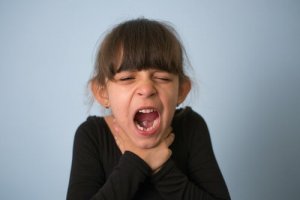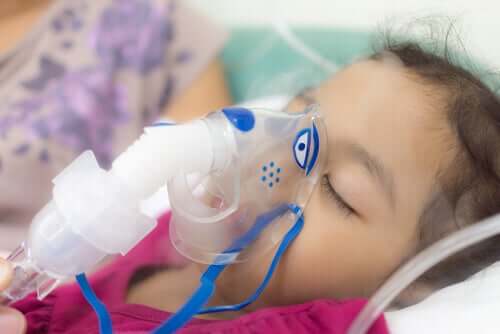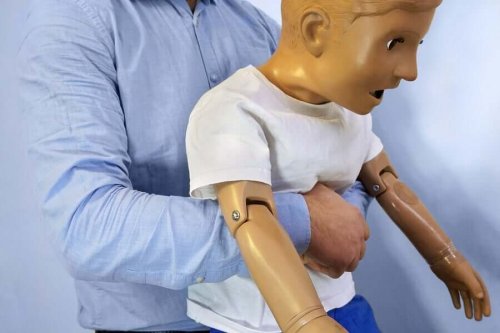Choking in Children: What to Do and How to Prevent It

According to available data, it’s estimated that choking in children is one of the most common non-natural accidents. Also, it’s the third leading cause of death in both childhood and old age. Therefore, it’s necessary to focus both on prevention and how to address it.
Choking prevention in children is the best alternative. Since it can lead to death, it’s best to eliminate the risks of it happening – mainly from four months of age, when it becomes a latent danger.
If you aren’t able to avoid this accident, you should know what to do to make sure the consequences aren’t serious. Simple first aid measures can save your child’s life, which is why you should be familiar with them.
Choking in children
In a more precise manner, choking in children is the obstruction of the airways by a foreign body. In the worst cases, the airways become completely obstructed, which doesn’t allow the air to reach the lungs, thus causing death.
Most of these cases of obstruction occur in children under three years of age. The highest peak occurs in children between 6 and 12 months of age. In most cases, children choke on food, which very often corresponds to a nut or hard candy.
Other hazardous foods are meat and sausages, as well as bones and fish bones. Due to their texture and shape, sausages are also risky. In general, any solid object that fits into a child’s mouth is also dangerous.

Read on: How to Resuscitate a Baby
Prevention measures
Choking in children has an unpredictable outcome. Thus, it’s best to prevent this accident. The first thing you should consider is that most of these cases occur when a child is eating or playing. Thus, it’s essential to supervise children during these activities.
Here are other preventive measures:
- Safeguard their complementary feeding and avoid certain foods. Nuts and fruits such as cherries or plums shouldn’t be within the reach of children under five or until you’re sure they know how to eat them.
- Small objects and toys. You shouldn’t leave small solid objects, such as batteries or marbles, within the reach of children. Be especially careful with balloons and similar toys, as they’re made of materials that adhere easily and can obstruct the airways.
- Feeding rules. Children should eat at the table and not lying down. Also, they shouldn’t eat while running or playing. You must teach them to chew properly.
- Avoid necklaces. Children should never wear necklaces, even less so if they’re made of balls or small objects.
Find out more here: What to Do When Someone is Choking
What to do in the case of choking in children

The Heimlich maneuver is a suitable and urgent method for choking in children. If choking occurs in a child despite preventive measures, the first thing you should do is stay calm. This allows you to rapidly assess the situation to know what you need to do. When a child is choking, the first thing they do is cough, talk, or cry.
If the child coughs, it’s best to let them and encourage them to keep doing it. Sometimes, inappropriate intervention makes the foreign object move, meaning it’s harder to extract. You have to avoid hitting the child’s back, pressing their abdomen, or giving them something to drink. When coughing doesn’t extract the object they’re choking on, you should call the emergency services and do the following before they arrive:
- Firstly, get them on their feet and make them tilt their head
- Put an arm under their armpit and hold their chest with your hand
- With your other hand, hit their upper back, between the shoulder blades. You should use the bottom of your palm and not hit them more than five times.
The Heimlich maneuver
If the child doesn’t eject the object they’re choking on, you should perform the Heimlich maneuver up to five times in a row. These are the steps you have to follow:
- You must get behind the child and put your arms around their waist.
- Make a fist with one of your hands and put your thumb knuckle above their navel, at the pit of their stomach.
- With your other hand, cover your fist and push inward and upward.
- If the child is unconscious, you should push their chest 30 times. Then, breathe twice into the child’s mouth, keeping their nose plugged. Keep doing this until help arrives.
he
All cited sources were thoroughly reviewed by our team to ensure their quality, reliability, currency, and validity. The bibliography of this article was considered reliable and of academic or scientific accuracy.
- Fernández San Millán, R. (2016). Estudio crítico de la maniobra de Heimlich en la asfixia por atragantamiento. https://uvadoc.uva.es/bitstream/handle/10324/35271/TFG-L2313.pdf?sequence=1&isAllowed=y
- AEP. (n.d.). Atragantamiento. EnFamilia AEP. https://enfamilia.aeped.es/prevencion/atragantamiento
- Romero-Velarde, E., Villalpando-Carrión, S., Pérez-Lizaur, A. B., Iracheta-Gerez, M., Alonso-Rivera, C. G., López-Navarrete, G. E., … & Chávez-Palencia, C. (2016). Consenso para las prácticas de alimentación complementaria en lactantes sanos. Boletín médico del Hospital Infantil de México, 73(5), 338-356. http://www.scielo.org.mx/scielo.php?script=sci_arttext&pid=S1665-11462016000500338
- Giraldi, M. P., & Durán, F. D. M. (2015). Alimentación complementaria en el lactante. Pediatr Integral, 19(4), 260-267. https://www.pediatriaintegral.es/wp-content/uploads/2015/07/Pediatria-Integral-XIX-4_WEB.pdf#page=36
- Murua, J. K., & Prado, O. S. (2012). Cuerpos extraños en la vía respiratoria. Protocolos de Urgencias Pediátricas. 2nd ed. Madrid: Ergón, SA. http://www.aeped.es/sites/default/files/documentos/cuerpo_ext_via_aerea.pdf
- Mayo Clinic Staff. (n.d.). Ahogamiento: primeros auxilios. Mayo Clinic. https://www.mayoclinic.org/es-es/first-aid/first-aid-choking/basics/art-20056637
- Rubiales Ordax, M. (2019). Los primeros auxilios: RCP básica y maniobra de Heimlich, en Educación Primaria. https://uvadoc.uva.es/handle/10324/39640
This text is provided for informational purposes only and does not replace consultation with a professional. If in doubt, consult your specialist.








